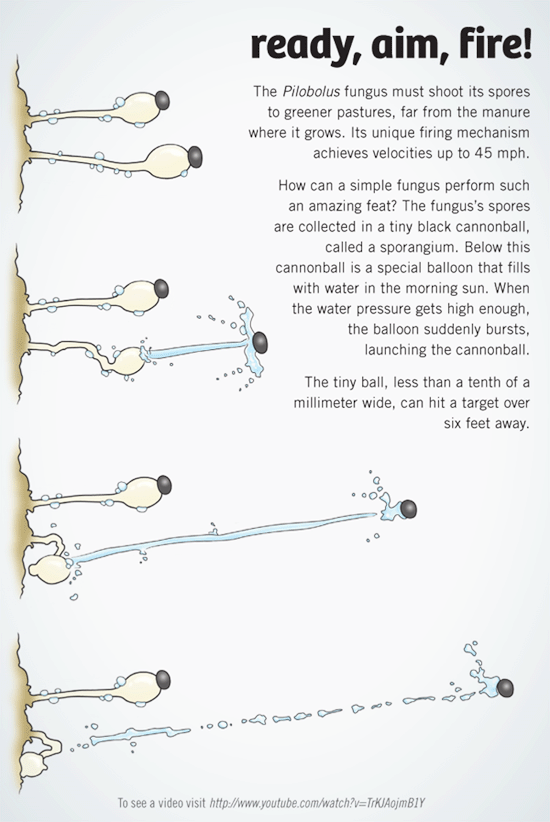Fungus Firearms
Every day on the cow pastures of the world, salvos are shot from dunghills. Few people have heard of these cannonball volleys, however, because they take place on such a miniature scale. The life cycle of the Pilobolus fungus shows how our Creator can display beautiful design even when disposing of manure.
When you think of cannonballs, the first thing that pops into your mind probably isn’t a tiny black speck the shape of a deflated ball. Yet more of these tiny projectiles are fired each day than all manmade cannonballs ever fired in military history.
Why do so few people know about these special little cannonballs? Easy. Because to see them you have to stick your face a few inches away from a fresh cow patty.
Several species of “hat-throwing fungus” in the genus Pilobolus live on the fresh dung of cattle, horses, deer, and other grass-eaters. Like all fungi, they are decomposers that consume dead or decaying matter. They start as spores, which grow into thin threads (called hyphae), feeding on the nutrient-rich manure. When the time comes to release new spores, specialized stalks, called sporangiophores, sprout and grow to a height of a centimeter or less. On top of these stalks appear the cannonballs, called sporangia, which contain the new spores.
Light-seeking Fiber Optics
This particular fungus has beautiful sporangiophores, which are transparent and shine like spun glass. How ironic that such jewels thrive in filthy surroundings. A bulge just below the cannonball-like sporangium is not just beautiful but serves as the cannon barrel.
To fire properly, the stalk must point toward the sun and fill with water. God designed the bulge to refract the sun’s rays into the base of the swelling, where certain pigments absorb the light. This happens in the morning when the sun is low on the horizon.
To ensure that the sporangium is shot to greener pastures, it needs to have a trajectory away from the home patty. Sporangia shot straight up in the air wouldn’t get far—the farther they’re shot, the better. So shooting toward a morning sun is the best strategy.
If the sporangiophore is not aimed directly at the sun, the light rays hitting the pigments unevenly will cause one side to grow more than the other until the sporangiophore is aimed right at the sun.
At the same time the bulge’s fluid (cytoplasm), which is very high in certain ions, causes water to flow into the bulge (by osmosis), increasing the fluid pressure to bursting levels.
Ready, Aim, Fire!
Once the sporangiophore is aimed at the sun, the water influx causes this bulging balloon to burst. The little black sporangium, mounted on top, is shot from its glistening perch with an initial velocity of about 45 mph (72 km/h). It speeds away in an arc and can land over 6 feet (2 m) away.
Not bad, considering the sporangium is less than one tenth of a millimeter wide. If it is lucky, the sporangium lands on a blade of grass a reasonable distance from its stinky source.
Why does it need these incredible ballistics? Because cattle find their own dung repugnant and won’t eat adjacent grass, Pilobolus needs to shoot its sporangia a good distance from the home patty. Landing on grass several feet away increases the chance of being eaten by another cow.
Most other fungi release their spores to the four winds. In so doing, only a tiny fraction of a fraction of their spores actually land on a suitable surface to grow. Also, most fungal spores of other related fungi are sprinkled out of the sporangium like pepper from a shaker.
Unlike these other fungi, for the Pilobolus to have successful offspring its sporangium needs to be eaten, processed through the gut of an herbivore, and deposited in a fresh pile of dung. So Pilobolus spores are kept inside a special protective sporangium, which is designed for successful sharp-shooting and surviving the hazardous journey sloshing about in digestive juices in a cow’s gut.
It Works!
If the tiny sporangium lands on a blade of grass several feet from the launch patty, a cow or some other herbivore may eventually come along and chomp off a mouthful of grass. The spores remain protected within the sporangium throughout the entire digestive tract. After the cow patty is deposited, the spores grow out of the sporangium, and the cycle begins anew.
Unwelcome Hitchhikers
Although Pilobolus sporangia are not harmful to cattle, often nasty stowaway parasites, called lungworms, take advantage of Pilobolus’s projectiles. Lungworm larvae, which are deposited in the same dung as the fungus, need to be eaten by an herbivore. They squirm up the stalk of the sporangiophore and crawl onto the sporangium. By this insidious method they can enter another grazing host.
Once ingested, they take a circuitous route to the lungs, where they become adults. Here the adults breed and often cause serious respiratory illnesses in a variety of livestock. Their offspring are coughed up and then swallowed into the digestive tract, where they again wind up in dung.
Pilobolus is an innocent accomplice. Left alone, it is a good little fungus. The creative hand of God has not only made Pilobolus an effective decomposer of dung but has also bestowed on it ballistic abilities to blast its offspring to a better place to continue its life cycle. Imagine how, in a perfect world before the Curse, this fungus went about its job recycling refuse without harm to anything.

Answers Magazine
April – June 2010
Debates about evolution and attacks on Scripture seem endless. But why should we be ashamed of truth? In this issue you’ll find basic truths revealed in Genesis and confirmed by science—bare-bones essentials that all Christians need. Also look for fascinating science news, ideas for a faith-building creation “stay-cation” to your local zoo, and semi-technical articles to strengthen your faith and challenge your mind!
Browse Issue SubscribeRecommended Resources

Answers in Genesis is an apologetics ministry, dedicated to helping Christians defend their faith and proclaim the good news of Jesus Christ.
- Customer Service 800.778.3390
- © 2025 Answers in Genesis





